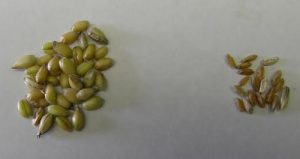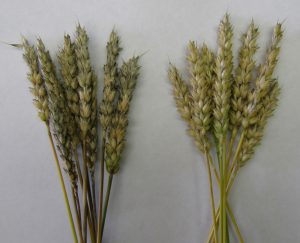Bulletin #1028, Fusarium Head Blight (Head Scab of Barley) and the occurrence of deoxynivalenol (vomitoxin)
Fusarium Head Blight (Head Scab of Barley) (PDF)
By Steven B. Johnson, Extension Crops Specialist, University of Maine Cooperative Extension
For information about UMaine Extension programs and resources, visit extension.umaine.edu.
Find more of our publications and books at extension.umaine.edu/publications/.
Fusarium head blight, or head scab of barley, is a devastating disease of small-grain cereals worldwide. The disease is caused by several fungi in the species Fusarium, most commonly Fusarium graminearum (Gibberella zeae). Fusarium culmorum, Fusarium pseudograminearum, Fusarium poae and others have also been reported to cause head scab. The pathogen may infect heads of small grains such as oats, rye, and spelt, but most notably wheat and barley, from flowering through kernel development. Fusarium head blight, or head scab, is a disease not only of small grains, but of many grasses including foxtail, quackgrass, crabgrass, and bluegrass. This fungus also causes stalk rot of corn.
Fusarium head blight can cause significant yield losses and quality reductions. Yield losses occur from lowering yields and test weights along with low seed germination. Quality reductions may also occur from seed discoloration. Deoxynivalenol (DON) or vomitoxin, a mycotoxin, is associated with head blight. DON is a protein inhibitor that may cause vomiting and feed refusal in livestock. DON can also cause dizziness, nausea, diarrhea, and muscle spasms in nonruminant animals, including humans. Elevated DON levels can lead to reduced milk production — or egg production in poultry — or reduced weight gain. Monogastric animals (swine) are more sensitive to DON than are ruminants or fowl. As DON is stable, levels remain unchanged for years in storage. Levels of DON in the grain cannot be determined visually: a laboratory test is required. While the presence of Fusarium head scab does not mean the presence of vomitoxin, high levels of vomitoxin may be expected from grain with high levels of Fusarium head scab. The DON levels present in harvested grain are determined by environmental conditions, species of fungus present, the severity of infection, and the crop species.
High levels of DON can render grain unacceptable for certain uses. The U.S. Department of Agriculture (USDA) recommends that DON levels in human foods not exceed 1 part per million (ppm). This advisory level is applied to the final product, not the grain. The U.S. Food and Drug Administration (FDA) has established vomitoxin advisory levels for grain and grain by-products used for animal feed as follows:
- Feedlot cattle, over 4 months old: 10 ppm
- Dairy cattle, over 4 months old: 5 ppm
- Chickens: 10 ppm (not to exceed 50 percent of diet)
- Swine: 5 ppm (not to exceed 20 percent of diet)
- Other animals: 5 ppm (not to exceed 40 percent of diet)
The FDA and USDA vomitoxin levels are advisory levels. Often, grain buyers demand these or lower levels of vomitoxin. Barley with elevated DON levels can adversely affect the beer malting and brewing process, leading to “gushing” in beer upon opening.
Biology
The severity of scab infection and resultant DON levels vary from year to year. Spores produced on infected heads serve as an inoculum for seed decay and seedling blight when the untreated infected seed is replanted. One disease cycle occurs annually. The pathogen can be carried on infected seed planted into the field, it may exist in the soil, or it may enter the field as wind-borne inoculum and spread rapidly via rain splash and wind. Infection can occur when the spores land on barley heads.
The head scab fungi persist and produce spores on previous small-grain crop residues. In particular, corn debris is one of the most abundant sources of inoculum. Barley flowers while still in the boot stage, so it is susceptible at that time, but the infection is most common after the flowering head emerges from the leaf sheath. The majority of the infection occurs during flowering. If the weather is dry during the critical period of flowering and shortly afterward, the barley crop may be free of head scab and DON. Conditions favorable for infection are relative humidity of greater than 90 percent and temperatures between 60°F and 85°F. If these conditions last 48 to 72 hours, infection is more likely. Head scab forecasting models are available for other barley-growing areas, but are under study in Maine and have not been validated. Early flower infection can produce shriveled kernels, referred to as “tombstones.” Late infections may appear healthy but can contain DON. While not always the case, the infection can continue until grain maturity under these conditions.
Symptoms
In the field, diseased grain kernels will have a light brown appearance, whereas the healthy seeds are green in the head. Diseased grain heads may become covered with dark fruiting bodies: a sign of the pathogen. Grain, if produced, tends to be light in weight and shriveled, and may appear chalky. Severe cases of Fusarium head blight may show a salmon-colored mass of the pathogen at the base of some glumes.
Management
Incorporate more than one of the following management strategies to minimize disease when conditions are favorable to the pathogen:
- Plant pathogen-free, well cleaned, certified seed.
- Rotate small-grain cereals with a broadleaf crop. Avoid corn in rotation, as Fusarium graminearum is a common corn pathogen. Separate barley fields as far as possible from no-till corn or conventional tillage corn fields where stalk residues remain on the soil surface. Complete soil incorporation of corn residue can reduce head blight by reducing inoculum.
- Use fungicides for Fusarium head blight control. The protection target is the flowering head. The critical period for protecting the head is before it emerges to about a week after emergence. Effectiveness of control is enhanced when spray nozzles are facing 30 degrees forward and 30 degrees backward as the protection target is the flowering head, rather than the leaves. Please consult current labels for appropriate control materials.
- Separate sections of fields or entire fields based on the visual presence of Fusarium head scab. This will allow these suspect areas to be harvested and stored apart from the main crop.
- Increase the fan speed in the combine to reduce the amount of shrivelled and tombstone grains collected. This practice, however, is not without cost, as the healthy grain will also be removed. Increased fan speed will remove some but not all of the Fusarium-infected grain, as many infected of the infected grain kernels are not shriveled. This practice has not been very successful with lighter grains such as barley.
- Dry harvested grain to 13.5 percent moisture as soon as possible after harvesting to stop the growth of Fusarium.
- Have any suspect grain analyzed by a laboratory for deoxynivalenol (DON) before feeding to humans or livestock.
- Consider a crop insurance policy for mycotoxin in grain.
Thanks to reviewer David Fuller, Extension Professional
Information in this publication is provided purely for educational purposes. No responsibility is assumed for any problems associated with the use of products or services mentioned. No endorsement of products or companies is intended, nor is criticism of unnamed products or companies implied.
© 2014
Call 800.287.0274 (in Maine), or 207.581.3188, for information on publications and program offerings from University of Maine Cooperative Extension, or visit extension.umaine.edu.
In complying with the letter and spirit of applicable laws and pursuing its own goals of diversity, the University of Maine System does not discriminate on the grounds of race, color, religion, sex, sexual orientation, transgender status, gender, gender identity or expression, ethnicity, national origin, citizenship status, familial status, ancestry, age, disability physical or mental, genetic information, or veterans or military status in employment, education, and all other programs and activities. The University provides reasonable accommodations to qualified individuals with disabilities upon request. The following person has been designated to handle inquiries regarding non-discrimination policies: Director of Equal Opportunity, 5713 Chadbourne Hall, Room 412, University of Maine, Orono, ME 04469-5713, 207.581.1226, TTY 711 (Maine Relay System).




